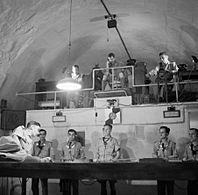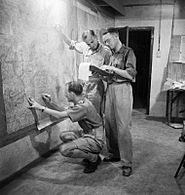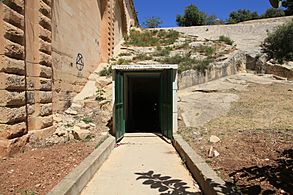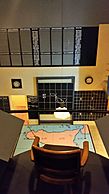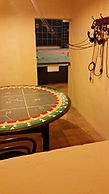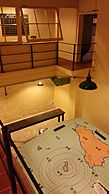Lascaris War Rooms facts for kids
Quick facts for kids Lascaris War Rooms |
|
|---|---|
| Valletta, Malta | |

Entrance to the War Rooms
|
|
| Coordinates | 35°53′40.19″N 14°30′39.78″E / 35.8944972°N 14.5110500°E |
| Site information | |
| Owner | Government of Malta |
| Controlled by | Fondazzjoni Wirt Artna |
| Open to the public |
Yes |
| Condition | Intact |
| Site history | |
| Built | 1940–1943 |
| In use | 1943–1977 |
| Battles/wars | World War II Suez Crisis |
The Lascaris War Rooms are a hidden network of tunnels and rooms deep underground in Valletta, Malta. This secret place was the main headquarters for defending the island during World War II. Later, a group called NATO used these rooms. Today, you can visit them as a fascinating museum.
Contents
Discovering the Lascaris War Rooms
A Secret Underground Headquarters
Work on these secret underground rooms started in 1940. This was during the Siege of Malta, a time when the island was under attack. The British expanded old tunnels beneath the Upper Barrakka Gardens and the Saluting Battery. These tunnels had been used as living quarters during the time of the Knights of St. John. The entire complex was finished by early 1943. The rooms are named after the nearby Lascaris Battery. This battery was named after Giovanni Paolo Lascaris, a Grandmaster who built a garden there long ago.
How the War Rooms Were Used
The Lascaris War Rooms had special operations rooms for each military branch. From here, they planned Malta's defense and other missions in the Mediterranean Sea. The main headquarters communicated directly with radar stations across Malta. It also used special coding machines called Type X. The Navy Plotting Room guided ships. The Anti-Aircraft Guns Operations Room managed the island's air defense. In the Coast Defence Room, they planned how to stop an invasion by sea. The Filter Room collected information from many places, including the naval station at Auberge de Castille.
Leading Important Missions
Lascaris was a key Allied headquarters during the war. In 1943, famous leaders like General Eisenhower and his top commanders worked here. Admiral Cunningham, Field Marshal Montgomery, and Air Marshal Tedder directed the Allied invasion of Sicily from these rooms. This invasion was known as Operation Husky.
Life in the War Rooms
During World War II, about 1000 people worked in the Lascaris War Rooms. This included 240 soldiers. They worked tirelessly to protect Malta and plan important missions.
After World War II
After the war ended, Lascaris became the main base for the Royal Navy's Mediterranean Fleet. The rooms were very active during the Suez Crisis in 1956. They were also on high alert during the Cuban Missile Crisis in 1962. People feared a missile attack on Malta from the Soviet Union at that time.
NATO's Role in Malta
In 1967, the complex was taken over by NATO. NATO is a group of countries that work together for defense. They used the war rooms as a communication center. Their job was to track Soviet submarines in the Mediterranean. The war rooms continued this important work until they closed in 1977.
Visiting the War Rooms Today
A Museum for Everyone
The complex was first opened to the public in 1992. It closed for a while in 2005. However, in 2009, Fondazzjoni Wirt Artna and the Malta Heritage Trust took over. They reopened the rooms, and restoration work began. As of 2025, the restoration is mostly complete. Visitors can now explore these historic rooms.
Future Plans for the Site
There are plans for the war rooms to become part of a larger Military Heritage Park. This park will include the war rooms and the old NATO Command Centre. It will also feature the SS Peter and Paul Counterguard, the Saluting Battery, and the crypt of the former Garrison Chapel.
Images for kids


